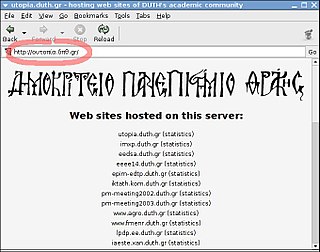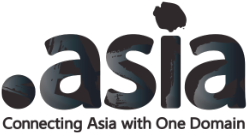
The Internet Corporation for Assigned Names and Numbers is a global multistakeholder group and nonprofit organization headquartered in the United States responsible for coordinating the maintenance and procedures of several databases related to the namespaces and numerical spaces of the Internet, ensuring the Internet's stable and secure operation. ICANN performs the actual technical maintenance work of the Central Internet Address pools and DNS root zone registries pursuant to the Internet Assigned Numbers Authority (IANA) function contract. The contract regarding the IANA stewardship functions between ICANN and the National Telecommunications and Information Administration (NTIA) of the United States Department of Commerce ended on October 1, 2016, formally transitioning the functions to the global multistakeholder community.
A top-level domain (TLD) is one of the domains at the highest level in the hierarchical Domain Name System of the Internet after the root domain. The top-level domain names are installed in the root zone of the name space. For all domains in lower levels, it is the last part of the domain name, that is, the last non-empty label of a fully qualified domain name. For example, in the domain name www.example.com, the top-level domain is .com. Responsibility for management of most top-level domains is delegated to specific organizations by the ICANN, an Internet multi-stakeholder community, which operates the Internet Assigned Numbers Authority (IANA), and is in charge of maintaining the DNS root zone.
A domain name registry is a database of all domain names and the associated registrant information in the top level domains of the Domain Name System (DNS) of the Internet that enables third party entities to request administrative control of a domain name. Most registries operate on the top-level and second-level of the DNS.
The domain com is a top-level domain (TLD) in the Domain Name System (DNS) of the Internet. Created in the first group of Internet domains at the beginning of 1985, its name is derived from the word commercial, indicating its original intended purpose for subdomains registered by commercial organizations. Later, the domain opened for general purposes.

.info is a generic top-level domain (gTLD) in the Domain Name System (DNS) of the Internet. The name is derived from information, although registration requirements do not prescribe any particular purpose.

An internationalized domain name (IDN) is an Internet domain name that contains at least one label displayed in software applications, in whole or in part, in non-Latin script or alphabet or in the Latin alphabet-based characters with diacritics or ligatures. These writing systems are encoded by computers in multibyte Unicode. Internationalized domain names are stored in the Domain Name System (DNS) as ASCII strings using Punycode transcription.

.cn is the country code top-level domain (ccTLD) for the People's Republic of China. Introduced on 28 November 1990, the domain is administered by China Internet Network Information Center, a public institution affiliated with the Ministry of Industry and Information Technology. The domain is the largest ccTLD in the world.
A country code top-level domain (ccTLD) is an Internet top-level domain generally used or reserved for a country, sovereign state, or dependent territory identified with a country code. All ASCII ccTLD identifiers are two letters long, and all two-letter top-level domains are ccTLDs.
Generic top-level domains (gTLDs) are one of the categories of top-level domains (TLDs) maintained by the Internet Assigned Numbers Authority (IANA) for use in the Domain Name System of the Internet. A top-level domain is the last level of every fully qualified domain name. They are called generic for historical reasons; initially, they were contrasted with country-specific TLDs in RFC 920.

.sg is the Internet country code top-level domain (ccTLD) for Singapore. It was first registered in September 1988. It is administered by the Singapore Network Information Centre. Registrations are processed via accredited registrars.
The Canadian Internet Registration Authority is the organization that manages the .ca country code top-level domain (ccTLD) for Canada. Its offices are located at 979 Bank Street in Ottawa, Ontario, Canada. CIRA sets the policies and agendas that support Canada's internet community and Canada's involvement in international internet governance. It is a member-driven organization with membership open to all that hold a .ca domain. As of March 2023, there were more than 3.3 million active .ca domains.

.tw is the Internet country code top-level domain (ccTLD) for Taiwan. The domain name is based on the ISO 3166-1 alpha-2 country code TW. The registry is maintained by the Taiwan Network Information Center (TWNIC), a Taiwanese non-profit organization appointed by the National Communications Commission (NCC) and the Ministry of Transportation and Communication. Since 1 March 2001, TWNIC has stopped allowing itself to sign up new domain names directly, instead allowing new registration through its contracted reseller registrars. As of May 2023, there are 17 registrars.

.in is the Internet country code top-level domain (ccTLD) for India. It was made available in 1989, four years after original generic top-level domains such as .com, .net and the country code like .us. It is currently administered by the National Internet Exchange of India (NIXI).

.ir is the Internet country code top-level domain (ccTLD) for Iran. It is managed by the Institute for Research in Fundamental Sciences.
The Japan Registry Services Co., Ltd. (JPRS) was incorporated on December 26, 2000. The organization manages the .jp ccTLD, including the operation of the registry and DNS servers.
Single-letter second-level domains are domains in which the second-level domain of the domain name consists of only one letter, such as x.com. In 1993, the Internet Assigned Numbers Authority (IANA) explicitly reserved all single-letter and single-digit second-level domains under the top-level domains com, net, and org, and grandfathered those that had already been assigned. In December 2005, ICANN considered auctioning these domain names.

The top-level domain .asia is the officially designated regional domain in the Internet for Asia and the Pacific. It is a sponsored generic top-level-domain (sTLD) operated by the DotAsia Organisation Ltd. The domain is open to companies, individuals and organisations that have a connection to the region. Asia domains can be seen and used by international and Asian businesses; regional conferences and symposiums; as well as Asian artists and celebrities.
A geographic top-level domain is any of an unofficial group of top-level domains in the Domain Name System of the Internet using the name of or invoking an association with a geographical, geopolitical, ethnic, linguistic or cultural community. The IANA does not recognize these domains as their own group within the Root Zone Database, rather classifying them as generic top-level domains.

The domain name tokyo is a top-level domain (TLD) for Tokyo in the Domain Name System of the Internet. On November 13, 2013, ICANN and GMO Registry entered into a registry agreement under which GMO Registry operates the tokyo TLD.










